Family name: Heliconiaceae (A. Richardson) T. Nakai
Synonym(s): [none]
Common name(s): heliconia family
*Number of genera/species: 1/194
List of genera records in GRIN-Global
fruit
Fruit a schizocarpschizocarp:
usually dry fruit splitting between two or more locules to form distinct, indehiscent, usually one seeded segments; fruit derived from a single, superior or inferior, compound ovary; compare to mericarp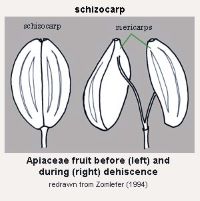 , splits into three fleshy mericarpsmericarp:
, splits into three fleshy mericarpsmericarp:
a one-seeded section (carpel) of a schizocarp, as in Apiaceae fruits (compare schizocarp)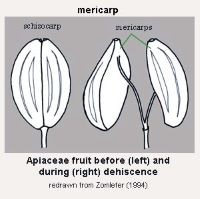 (often interpreted as drupesdrupe:
(often interpreted as drupesdrupe:
(indehiscent drupe) a fleshy, indehiscent fruit with one more hard pits enclosing seeds, derived from single, superior, simple or compound ovary; (dehiscent drupe) a fruit with a dry or fibrous to fleshy or leathery outer husk that early to tardily breaks apart (or opens), exposing one or more nutlike pits enclosing the seeds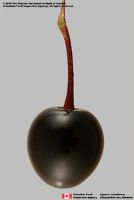 ), 7–21 mm long, squaresquare:
), 7–21 mm long, squaresquare:
2D shape—geometric figure bounded by 4 straight sides of equal length and 4 90º-angles
to trigonoustrigonous:
3D shape—having three faces that meet at distinct angles; triangular in outline
, angledangular:
2D shape—having sides that meet at acute or obtuse angles
in transection, each mericarpmericarp:
a one-seeded section (carpel) of a schizocarp, as in Apiaceae fruits (compare schizocarp) with operculateoperculum:
with operculateoperculum:
a dehiscent cap (or lid) of a seed or fruit that opens during germination or dehiscence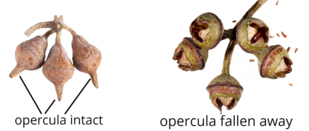 single-seeded thick-walled stone. Pericarppericarp:
single-seeded thick-walled stone. Pericarppericarp:
fruit wall or fruit coat
usually blue, sometimes red, orange or yellow, thin, smooth, sometimes pubescentpubescent:
surface relief—bearing hairs
.
Seeds triangulartriangular:
2D shape—three relatively straight sides with distinct corners; more angular than teardrop-shaped , each with an operculumoperculum:
, each with an operculumoperculum:
a dehiscent cap (or lid) of a seed or fruit that opens during germination or dehiscence but no micropylar collarmicropylar collar:
but no micropylar collarmicropylar collar:
collar shaped tissue at micropyle
, 10–17 mm long. Seed coat hard, ridgedridged:
surface relief—raised, thick ridges, sharp edged or rounded, usually in a series that may cover the entire surface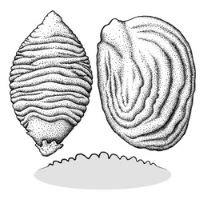 , pittedpitted:
, pittedpitted:
surface relief—surface with small depressions in which the areas between the hollows do not take on the appearance of a true reticular net , or wartywarty:
, or wartywarty:
surface relief—distinct, rounded projections that are large relative to the fruit size; tuberculate, verrucose , with a larger than punctatepunctate:
, with a larger than punctatepunctate:
surface relief—dotted with pits or with translucent, sunken glands or with colored dots, similar to pitted hilumhilum:
hilumhilum:
on seeds, the scar indicating where the funiculus was attached; on grass caryopses, the scar visible on the outer fruit surface revealing where the seed is attached on the inner fruit wall surface; or in Asteraceae cypselae, the scar visible on the outer fruit wall revealing where the fruit was attached to the receptacle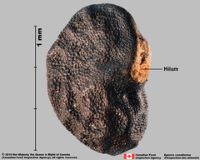 .
.
Embryo well developed, foliatefoliate:
appearing leaf-like
or linearlinear:
(shape) long, narrow, and uniform in width; (of embryo) embryo is straight and much longer than wide , straight, basalbasal:
, straight, basalbasal:
at or pertaining to the point of attachment; (of embryo) embryo occupies one end of the seed
, embedded in nutritive tissue, sometimes acotyledonous.
Endosperm copious; thin perispermperisperm:
seed nutritive tissue comparable to the endosperm, but derived from the nucellus (maternal tissue)
also present.
| Fruit | |
| Type | schizocarpschizocarp: usually dry fruit splitting between two or more locules to form distinct, indehiscent, usually one seeded segments; fruit derived from a single, superior or inferior, compound ovary; compare to mericarp  , splits into drupaceous mericarpsmericarp: , splits into drupaceous mericarpsmericarp:a one-seeded section (carpel) of a schizocarp, as in Apiaceae fruits (compare schizocarp)  |
| Size range | 7–21 mm long |
| Shape(s) | squaresquare: 2D shape—geometric figure bounded by 4 straight sides of equal length and 4 90º-angles , trigonoustrigonous: 3D shape—having three faces that meet at distinct angles; triangular in outline |
| Texture | fleshy |
| Surface relief | smooth |
| Color(s) | blue, red, orange, yellow |
| Unique features | Usually blue, squaresquare: 2D shape—geometric figure bounded by 4 straight sides of equal length and 4 90º-angles schizocarpsschizocarp: usually dry fruit splitting between two or more locules to form distinct, indehiscent, usually one seeded segments; fruit derived from a single, superior or inferior, compound ovary; compare to mericarp  , with thin pericarps, which split into three drupaceous mericarpsmericarp: , with thin pericarps, which split into three drupaceous mericarpsmericarp:a one-seeded section (carpel) of a schizocarp, as in Apiaceae fruits (compare schizocarp)  . . |
| Seed | |
| Size range | 10–17 mm long |
| Shape(s) | tri angularangular: 2D shape—having sides that meet at acute or obtuse angles |
| Surface relief | ridgedridged: surface relief—raised, thick ridges, sharp edged or rounded, usually in a series that may cover the entire surface  , pittedpitted: , pittedpitted:surface relief—surface with small depressions in which the areas between the hollows do not take on the appearance of a true reticular net  , wartywarty: , wartywarty:surface relief—distinct, rounded projections that are large relative to the fruit size; tuberculate, verrucose  |
| Unique features | Seeds triangulartriangular: 2D shape—three relatively straight sides with distinct corners; more angular than teardrop-shaped  , each with an operculumoperculum: , each with an operculumoperculum:a dehiscent cap (or lid) of a seed or fruit that opens during germination or dehiscence  but no micropylar collarmicropylar collar: but no micropylar collarmicropylar collar:collar shaped tissue at micropyle , exarillate, with hard, sculptured seed coats. |
| Other | |
| Embryo | well developed, foliatefoliate: appearing leaf-like or linearlinear: (shape) long, narrow, and uniform in width; (of embryo) embryo is straight and much longer than wide  , straight, basalbasal: , straight, basalbasal:at or pertaining to the point of attachment; (of embryo) embryo occupies one end of the seed , embedded in nutritive tissue, sometimes acotyledonous. |
| Nutritive tissue | endosperm copious, perispermperisperm: seed nutritive tissue comparable to the endosperm, but derived from the nucellus (maternal tissue) thin |
Mostly tropical America, few species in Melanesia.
![]()
Distribution map courtesy of Angiosperm Phylogeny Website.
Baskin and Baskin 2021Baskin and Baskin 2021:
Baskin C and Baskin J. 2021. Relationship of the lateral embryo (in grasses) to other monocot embryos: A status up-grade. Seed Science Research 31 (3): 199-210. doi:10.1017/S0960258521000209; Dahlgren et al. 1985Dahlgren et al. 1985:
Dahlgren RMT, Clifford HT, and Yeo PF. 1985. The families of the monocotyledons: structure, evolution, and taxonomy. Springer-Verlag, Berlin. 520 pp.; Davidse et al. 2009–2018Davidse et al. 2009–2018:
Davidse GM, Sousa Sánchez M, Knapp S. and Chiang Cabrera F, eds. 2009–2018. Flora Mesoamericana. Missouri Botanical Garden, St. Louis, MO. Accessed: January–April 2024. URL: http://legacy.tropicos.org/Project/FM; Kirkbride et al. 2006Kirkbride et al. 2006:
Kirkbride JH, Jr, Gunn CR, and Dallwitz MJ. 2006. Family guide for fruits and seeds, vers. 1.0. Accessed September 2020-January 2022. URL: https://nt.ars-grin.gov/seedsfruits/keys/frsdfam/index.cfm .; Kubitzki et al. 1990+Kubitzki et al. 1990+:
Kubitzki K et al., eds. 1990+. The families and genera of vascular plants. 7+ vols. Berlin etc.; Stevenson and Loconte 1995Stevenson and Loconte 1995:
Stevenson DW and Loconte H. 1995. A cladistic analysis of monocot families. In: Rudall PJ, Cribb PJ, Cutler DF, and Humphries CJ, eds. Monocotyledons: Systematics and Evolution. Royal Botanic Gardens, Kew.; Watson and Dallwitz 1992+Watson and Dallwitz 1992+:
Watson L and Dallwitz MJ. 1992+. The families of flowering plants: descriptions, illustrations, identification, and information retrieval. Version: 6th Accessed September 2020-September 2022. URL: delta-intkey.com
*The number of genera and species is based on Christenhusz and Byng 2016Christenhusz and Byng 2016:
Christenhusz MJM and Byng JW. 2016. The number of known plant species in the world and its annual increase. Phytotaxa 261 (3): 201-217. https://doi.org/10.11646/phytotaxa.261.3.1, which may differ from the number of genera in GRIN-Global.